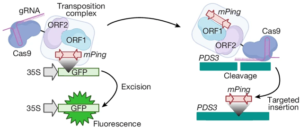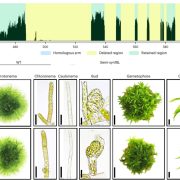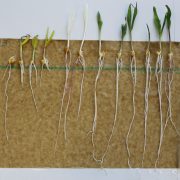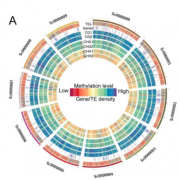Transposase-assisted target-site integration for efficient plant genome engineering
 Genome editing stands at the forefront of scientific innovation, offering transformative possibilities to manipulate the genetic code of plants, animals, and humans. A critical bottleneck for its application in modern crop improvement is the low frequency and error-prone integration of foreign DNA into the plant genome. While the rapid development of CRISPR/Cas system, which functions like a pair of molecular “scissors” to cut the genome, allows site-specific changes to the DNA, current methods lack robust ways to add custom DNA accurately and efficiently at the cut sites. To address this, Liu and colleagues developed a “cut-and-paste” genome editing toolkit using Transposase-Assisted Target Site Integration (TATSI) technology. This method significantly improves the efficiency and accuracy of DNA integration. Plant transposable elements naturally function as molecular “glue” to insert DNA into the genome. When combined with CRISPR/Cas, this “scissors + glue” combination enables custom DNA integration at specific sites within the plant genome. This innovative system has proven effective in the model plant Arabidopsis and soybean, a rapidly growing crop model due to its critical role as a global source of protein and oil. This advancement in genome editing technology holds great promise for enhancing crop improvement and addressing global agricultural challenges. (Summary by Ching Chan @ntnuchanlab) Nature 10.1038/s41586-024-07613-8
Genome editing stands at the forefront of scientific innovation, offering transformative possibilities to manipulate the genetic code of plants, animals, and humans. A critical bottleneck for its application in modern crop improvement is the low frequency and error-prone integration of foreign DNA into the plant genome. While the rapid development of CRISPR/Cas system, which functions like a pair of molecular “scissors” to cut the genome, allows site-specific changes to the DNA, current methods lack robust ways to add custom DNA accurately and efficiently at the cut sites. To address this, Liu and colleagues developed a “cut-and-paste” genome editing toolkit using Transposase-Assisted Target Site Integration (TATSI) technology. This method significantly improves the efficiency and accuracy of DNA integration. Plant transposable elements naturally function as molecular “glue” to insert DNA into the genome. When combined with CRISPR/Cas, this “scissors + glue” combination enables custom DNA integration at specific sites within the plant genome. This innovative system has proven effective in the model plant Arabidopsis and soybean, a rapidly growing crop model due to its critical role as a global source of protein and oil. This advancement in genome editing technology holds great promise for enhancing crop improvement and addressing global agricultural challenges. (Summary by Ching Chan @ntnuchanlab) Nature 10.1038/s41586-024-07613-8








